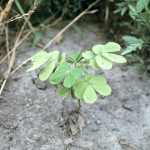Sicklepod Senna
Senna obtusifolia
Fabaceae (Legume family)
Description
Sicklepod senna is a foulsmelling herb that grows up to 5 feet tall. It is widely spreading with numerous ascending, hairless branches. The compound leaves are arranged spirally and usually have three pairs of symmetrically eggshaped leaflets up to 2 inches long. One to three yellow flowers appear on short axillary stems. The linear pods grow to 8 inches long, curve downward and contain many shiny, angular seeds.
Habitat
Sicklepod senna is found in the eastern third of Texas and extends eastward to Florida and north to Indiana and Pennsylvania. It usually grows in disturbed sandy soil and has been a troublesome weed in crops such as corn and soybeans.
Toxic Agent
The toxic agent of sicklepod senna is unknown. The foliage of this plant appears to be more toxic than the mature seed. In some cases, cattle were poisoned when sicklepod foliage was included in green chop or silage, or when they were forced to consume the plant because other nutritious forage was lacking. A large amount of plant material must be consumed over several days to cause poisoning.
Signs of Livestock Ingestion
Signs of poisoning by sicklepod senna relate to muscle damage and gastrointestinal disturbance and can include: Diarrhea; Weakness; Incoordination; Dark, coffee-colored urine; "Alert downers"-not depressed, will eat, but unable to rise; Death.
Most down animals remain bright-eyed and alert, and continue to eat when feed and water are placed before them. Most down animals do not recover.
Management Strategies
Do not cut forage for silage or green chop when it contains sicklepod senna. Take chemical control measures when these plants are growing in corn destined for green chop or silage. Cattle on short or overmature, unpalatable grass should not have access to this senna.
Images
Plant Characteristics
Flower Color: Yellow
Seed Type: Bean/Pod
Duration: Perennial
Stem Texture: Hairless/Smooth
Growth Habit: Forbs/Broadleaf
Leaf Shape
 : Pinnately Compound
: Pinnately Compound
Season: Warm
Distribution
 : 01 - Pineywoods, 02 - Gulf Prairies and Marshes, 03 - Post Oak Savannah, 04 - Blackland Prairies, 06 - South Texas Plains
: 01 - Pineywoods, 02 - Gulf Prairies and Marshes, 03 - Post Oak Savannah, 04 - Blackland Prairies, 06 - South Texas Plains
Distributions
Distribution refers to the ecological region in Texas that a plant has been found. You can also view a clickable map.
Book: Toxic Plants of Texas (B-6105)
Collection: Toxics, Wild Flowers
Livestock Affected: Cattle, Goats, Horses, Sheep
Livestock Signs: Abnormal Urination, Collapse, Depression/ Weakness, Diarrhea, Incoordination





